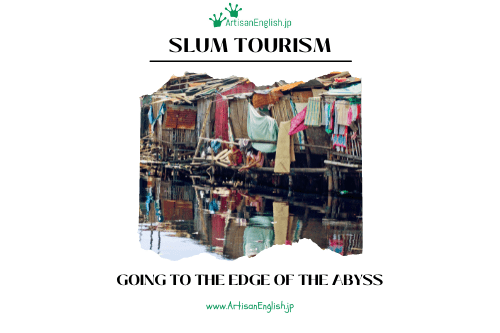
YouTube / iTunes / Spotify / Radio Public / Pocket Casts / Google Podcasts / Breaker / Overcast
Listen to ArtisanEnglish.jp posts & lesson intros here.
WotD: Slum tourism
Slum tourism, poverty tourism, or ghetto tourism is a type of city tourism that involves visiting impoverished areas.
Initially focused on the slums and ghettos of London and Manhattan in the 19th century, slum tourism is now prominent in South Africa, India, Brazil, Kenya, the Philippines, Russia and even the United States.
Most of the time, people visit townships, favelas, barrios, shantytowns, ghettos or slum areas out of morbid curiosity.
Slum tourism, poverty tourism, or ghetto tourism is a type of city tourism that involves visiting impoverished areas.
Although you may be shocked, slum tourism is nothing new and has historical references.
In the 19th century, wealthy people would go to the slums of London and New York to witness the poverty and misery of others.
The famous American author Jack London once visited and stayed in the slums of Whitechapel, East London, then wrote a book about it called The People of The Abyss.
Slum tourism is a profitable sector of the tourism industry, but it is also a troubling one.
There are plenty of tour companies that take tourists to see how the other half lives.
To some extent, it can help bring awareness of the inequality and poverty of these communities to those who are not familiar with it.
On the other hand, these tours also teach the public to look at the poverty and suffering of others as something worthy of fascination and to view impoverished people as primitive or inferior.
The problem is that they do not see the other half of their own countries reflected in what they think only exists to be the lower classes in India or South Africa.
Flesch-Kincaid Readability Test
This post is understandable by someone with at least a 9th-grade education (age 15).
On the Flesch-Kincaid reading-ease test, this post scores 53.
The easier a passage is to read, the higher the score on a scale of 0 – 100.